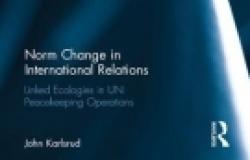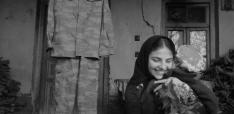Book Review: Norm Change in International Relations: Linked Ecologies in UN Peacekeeping Operations

Norm Change in International Relations: Linked Ecologies in UN Peacekeeping Operations by John Karlsrud. Abingdon, UK: Routledge, 2016. 172 pp., £90 hardcover 978-1-1389-4270-7
Peacekeeping, although not explicitly mentioned in the Charter of the United Nations, has evolved over a lengthy period of time and can be seen as a product of growth through practice. Its evolution has been neither a linear progress nor has it always been the most effective tool used in navigating the challenging road from conflict and instability to peace and security. UN peacekeeping, guided by three core and often-contradictory principles, has in many cases been in a prolonged state of tension with itself. Frequently seen as a singular and unified activity, acting on a coherent understanding and acceptance of guidelines and norms, agenda, agenda setting, and agency within the UN, peacekeeping presents a landscape of fragmentation and conflict in its own right.
Karlsrud’s book features seven chapters that begin with a concise and direct account of the norm change process in international relations and in UN peacekeeping in the post-Cold War period. This book is the product of numerous interviews, and a first-hand account of what peacekeeping operations conducted by the UN entail, given the author’s personal background in the field. He also skilfully draws upon primary literature from the UN, including many UN Security Council Resolutions, and other notes and reports. Employing practice theory and the sociology of professions, Karlsrud extends current understandings of norm change that he states is “change in established practices in the organization, change that transforms the relationship and relative balance between norms – for example, between the norms of sovereignty and the protection of civilians or between impartiality and supporting state authority” (p. 26).
Chapters 3 to 6 constitute the main body of the book. Karlsrud’s work focuses on the bottom-up perspective or what he refers to as the perspective “from the field” in Chapter 3. He begins with the understanding that UN peacekeeping adheres to the three core principles of impartiality, party consent, and not resorting to force. Despite the UN’s central authority and formal structure, Karlsrud depicts the underlying friction between this and the actions of Special Representatives of the Secretary General (SRSG). SRGC efforts in the field, though they are supposedly an extension of UN authority, “showed a certain level of decentralized authority and relative autonomy” (p. 64).
Chapters 4 and 5 hone in on linked ecologies as the crucial factor in norm change in peacekeeping operations, because of UN reliance on external actors to facilitate its strategic objectives and also its ground-level work. Viewing R2P as a fertile field for norm change, the process of integrated missions between 2003 and 2007 is shown to be an example of principle and norm advancement in international organizations (IOs). But there are also actors within these processes, and Karlsrud (p. 95) looks to Norway as one such actor asking “whether Norway can be seen as a norm entrepreneur employing a linked ecology strategy, working with the UN Department of Peacekeeping Operations (DPKO) and other parts of the UN.”
Chapter 6 presents the UN system as a “the primary arena for advancing norms,” with some states (Norway in this case) viewing the UN “as the world’s central norm-setter, and arena for drawing up rules that many are bound by” (Johansen, 2009 quoted in Karlsrud, 2016: p. 117). Karlsrud carefully builds on two ways of viewing the arena concept. Rather than accepting the UN as a dichotomy of competition or cooperation between states, he treats the UN as a porous system subject to externalities such as norms that have already been established or principles accepted by state and non-state actors (NSAs) around the world. NSAs act as bridges between the UN and other states in the international system – serving as “brokers” on many issues such as human rights and other issues championed by activists and practitioners (p. 132).
Karlsrud has generated a complimentary set of research questions that bring one to the heart of the UN, as well as its character, ambitions, and limitations in the world. Karlsrud’s focus reveals the competing interests in the UN, which could be the result of multiple voices involved in seeing UN operations through to completion and even success. There is a hidden danger in this story of external agents working together in the UN arena. If they do not hold the same opinions or beliefs about UN peacekeeping then the success of each mission could fluctuate dramatically and may yield malign results. If they realize that the UN is a place where specific norm endeavors can be interrupted through outside action, then norms and efforts toward their establishment could be greatly disrupted, hindering their intended goals on the ground. Karlsrud also investigates the problem of reliance on ground-level workers representing the UN and its mandates.
Karlsrud sets up his study so as to accommodate subsequent research pathways. His book is far from the final approach to the topic. Firstly, his analyses can be complimented with further intensive investigations by looking to build on the origins of the peacekeeping principle, either by extending the existing framework or by applying divergent scholarly approaches such as international relations theories, combined with anthropological, sociological, or gender bases. Secondly, extending the cases to other geographic locales could lead to a reinforcing of already soundly argued and well supported findings, but also potentially to variation (call this potential weakening) of the findings as they are stated in the book. Thirdly, and further to the previous point, fruitful inquiry could be made in terms of further “mapping” of the limits of ground-level actors’ roles and influences. Do individuals always figure positively in the context of the missions for which they are selected? This last question extends from the investigation within the book related to a one-size-fits-all conception and the still-troubling ambiguity “deep-seated in UN peacekeeping” (p. 145).
Although it may not be surprising that the UN relies on cooperation with its many member states, academics, social groups and non-governmental organizations, and research institutions and think tanks, Karlsrud’s work contends that the UN operates well beyond the limits of its own charter and either allows for or overlooks its SRSGs and missions departing from the core principles of peacekeeping. Adding to this peculiarity, Karlsrud has also demonstrated that the UN, at times, “seeks to co-opt these actors to achieve a controlled knowledge production that suits the goals of the organization” (p. 148). Because of the vast influence that professionals (including economists, sociologists, international affairs practitioners, research experts at think tanks, government officials, and diplomats) have on peacekeeping missions, a further puzzlement centered on peacekeeping as a concept arises.
Even though the UN and its norm change process and practices owe much to the conflictual spaces in which they occur, Karlsrud astutely shows that “norm change processes are never linear” (p. 149). The so-called “constitutive pillars” that form ecology linking, as articulated in the book’s final section, reveal almost something unsettling about the role (rather its extent) that the UN plays in norm change. Either the UN is the norm actor that one intuitively assumes it to be, or it is also a competitive arena in which and with which external actors can advance their own interests, possibly assisting in the progression of principles and norms that serve their own interests first and foremost and even compete against norms that have come to define the essence of the UN.
A valuable and creative contribution to the continuing literature on norm change and evolution theory, this book’s eclectic methodology combines with a mix of theories that form a unique conceptual framework, enabling Karlsrud to gain access to the highly detailed and intricate internal and external mechanisms of the UN and its norm change endeavors. It is by turning to and examining those players, which have been overlooked for such a long time in the context of UN peacekeeping operations, that this book is a welcome contribution to several overlapping bodies of literature dealing with theoretical and substantive issues. It should, furthermore, serve as a useful teaching tool for students looking to deepen their understanding of norm change in the international system. For professionals, this book represents an opportunity to enrich understandings of their own roles in an overwhelmingly influential field. This highly specialized study, with its fine-tuned and tight focus, has extended to the topic of UN peacekeeping missions the attention that it has been deserving of for many years, and is likely to lay the groundwork for future studies for many more.
Scott Nicholas Romaniuk is a PhD Candidate in International Studies (University of Trento). His research focuses on asymmetric warfare, counterterrorism, international security, and the use of force. E-Mail: scott.romaniuk@unitn.it.


